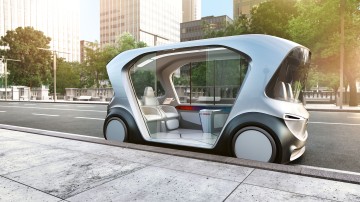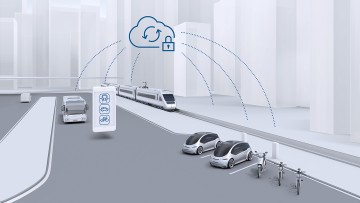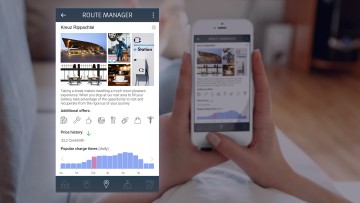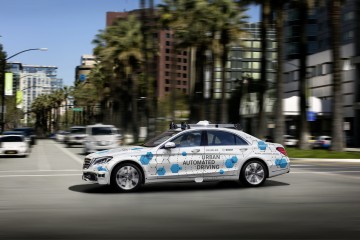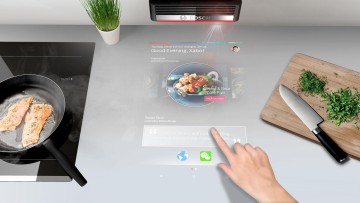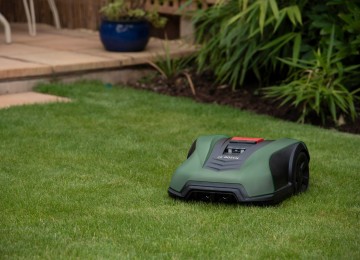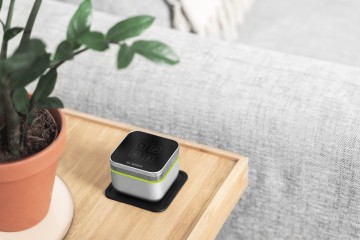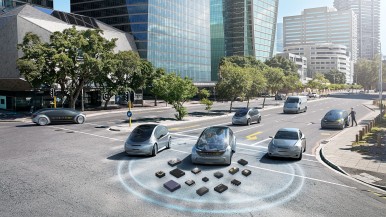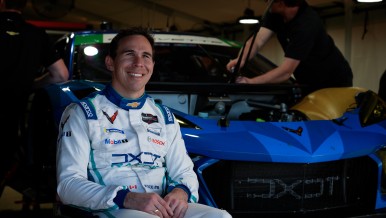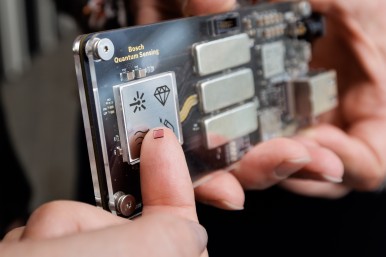2. Trucks with no exterior mirror:
The new Mercedes-Benz Actros is the first production truck to feature a camera system in place of conventional main and wide-angle mirrors. Known as Mirror Cam, this system offers better 360-degree vision. In addition to increasing safety, having compact digital cameras instead of mirrors improves the truck’s fuel consumption thanks to the cameras’ considerable aerodynamic advantages. Two cameras, fitted left and right on the roof of the driver’s cab, feed real-time images to two high-resolution 15-inch displays mounted on the A-pillars inside the cab. The system adjusts the monitor display to match the driving situation. Overall, Mirror Cam greatly improves the truck’s aerodynamics, safety, and vehicle handling. Daimler’s development partners for the Mirror Cam system are Bosch and Mekra Lang.
3. The smartphone as car key:
The Bosch Perfectly Keyless access system will soon let car drivers, car-sharing fleet operators, and logistics companies manage their vehicle keys digitally. They can use a smartphone app to decide at any given time who should have access to cars or trucks and when. The ingenious feature of this Bosch system is that it makes the connection between smartphone and vehicle more secure than ever. Perfectly Keyless can pinpoint the authorized smartphone like a digital fingerprint. For CES 2019, Bosch has installed the system in a demonstration vehicle based on a Ford Mustang.
4. Radar-based assistance systems prevent motorcycle accidents:
Blind-spot detection, collision warning, and adaptive cruise control: giving motorcycles radar as a sensory organ enables new motorcycle assistance and safety functions while providing an accurate picture of the vehicle’s surroundings. As a result, these assistance functions not only increase safety, they also enhance enjoyment and convenience by making life easier for riders. According to Bosch accident research estimates, radar-based assistance systems could prevent one in seven motorcycle accidents. These electronic assistants are always vigilant and, in emergencies, they respond more quickly than people can. They are based on a combination of radar sensor, brake system, engine management, and HMI.
5. App for connecting e-scooters:
A new app turns e-scooters into connectivity pros. As well as displaying key information such as the e-scooter’s current battery charge, it allows rider-vehicle communication and the option to connect with other users via social networks. This makes it easy for users to find out which of their friends are in the area. In addition, there is a connected helmet holder on the e-scooter’s handlebar which is controlled by app. Whenever the e-scooter is parked, this provides a storage solution for the helmet while also protecting the vehicle against theft and its display against vandalism.
6. Retrofit solution for more efficient machinery and households:
Bosch has developed the Phantom algorithm to help small and medium-sized enterprises assess and greatly increase the energy efficiency of their machinery. This retrofit solution, which takes just a few minutes to install, uses sensors to measure the load on each device in the customer’s energy consumption network to provide valuable insights into usage and potential faults. This enables users to improve the machinery’s operations and efficiency. In homes, too, Bosch Phantom can tell how much power each device is using. This energy transparency makes it possible to save electricity.
Mobility of the future: selection of solutions and services
Driving electric, yet stress-free – that is the goal of Convenience Charging, the Bosch service that the company is presenting at CES 2019 in a demonstration vehicle based on an Audi A3 e-tron. This integrated charging and navigation solution enhances the everyday benefits of electromobility. In the future, the service will tell electric cars precisely when their power will run out, but also where they can find the next charge spot. To this end, Convenience Charging combines information from the electric powertrain with both vehicle and environment data to produce a reliable range forecast. The service uses state-of-the-art route planning to determine charging opportunities based on the driver’s personal preferences. In the future, drivers of electric cars will be able to order food for delivery directly to their pre-booked charge spot, so they can make the best use of the charging time. Using the Convenience Charging app, drivers will also be able to plan the charging stops they need in the comfort of their own home, with the app then seamlessly transmitting the suggested routes between charge spots to the vehicle.




